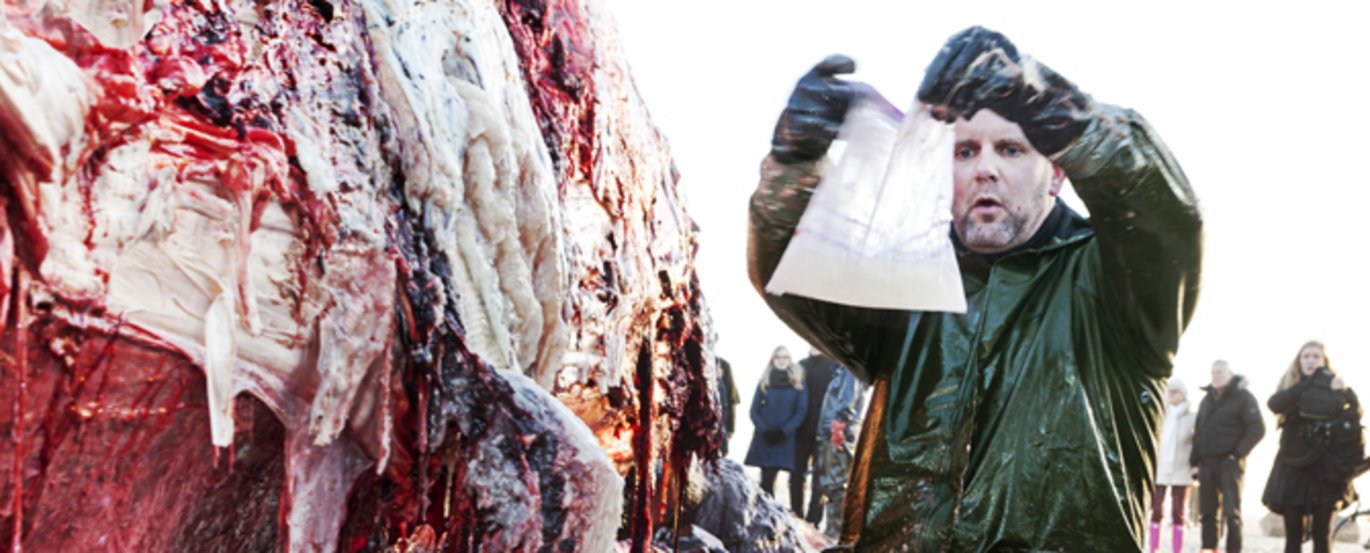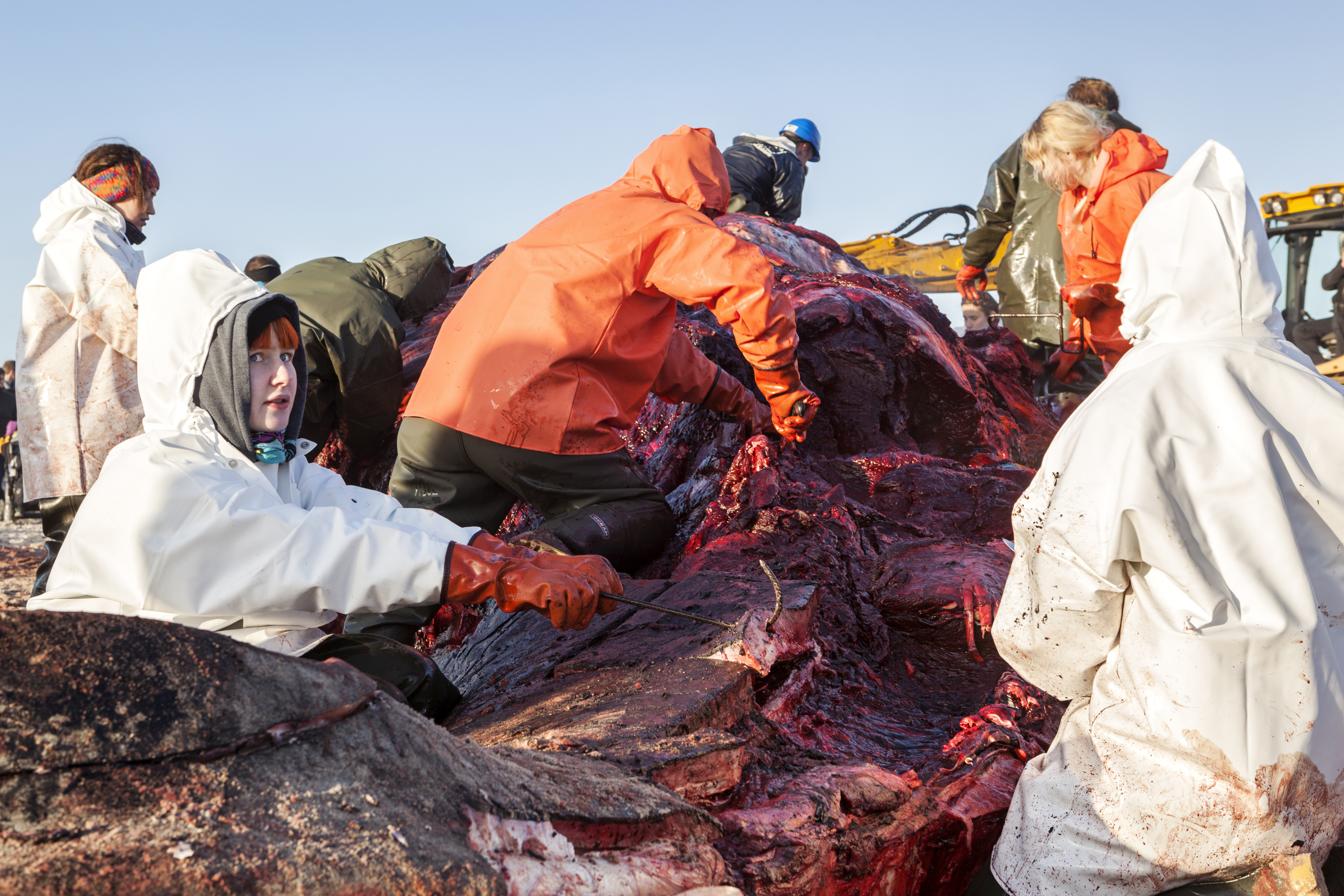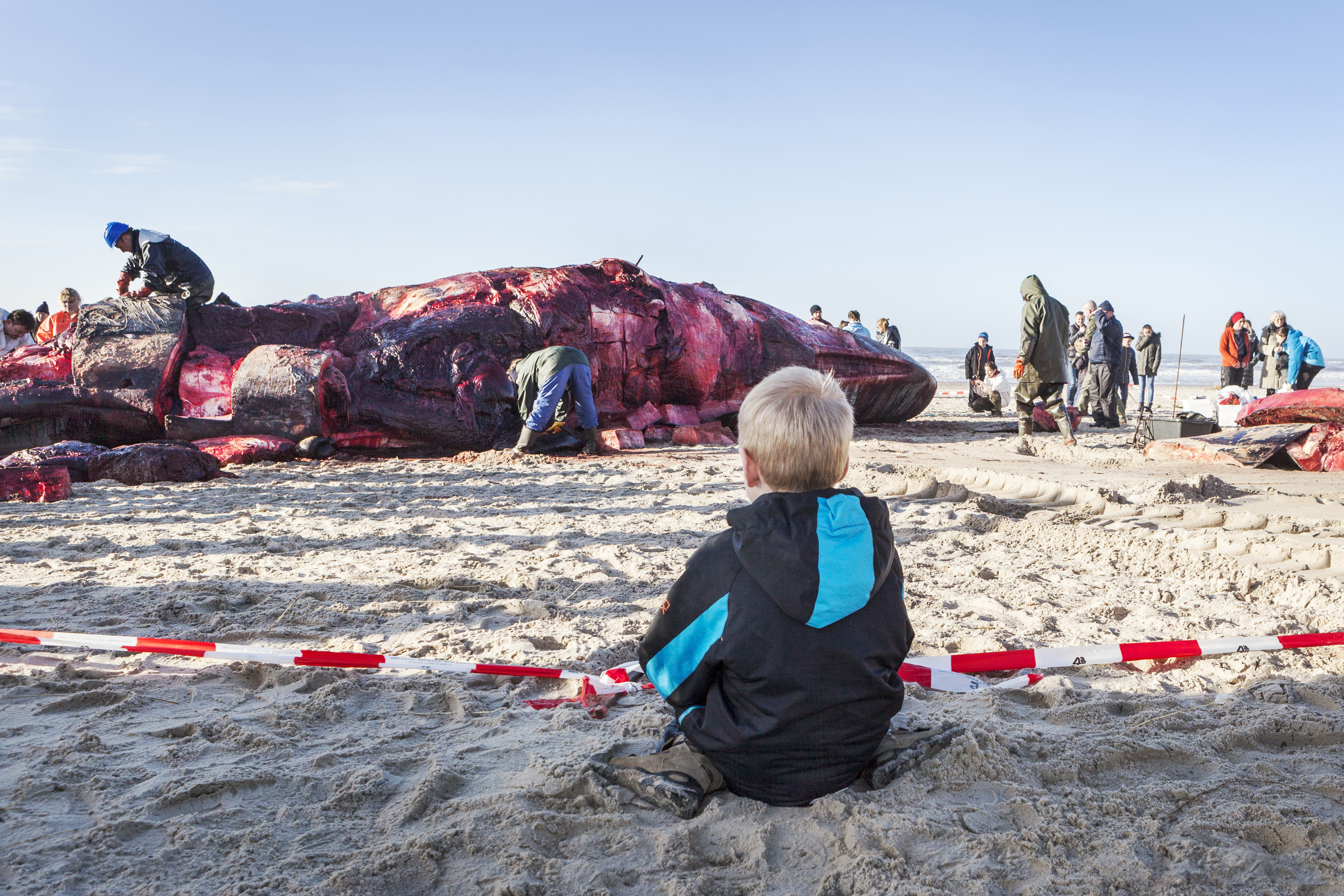Having a whale of a time
Whale researcher Peter Teglberg Madsen examines the equipment in front of him outside the Department of Bioscience in Aarhus. Knives? Check. Transparent plastic bags? Check. Duct tape? Check. Master’s and PhD students? Check.







The Master’s and PhD students who flock around Madsen have his full attention as he gives them some final information before departure:
"We’re going to be wading in whale. If you brought extra shoes, use them. If not, then put some plastic bags over the ones you’ve got on. And if you get it on your clothes then I’d rather have you ride home naked! Otherwise I’ll have a really hard job getting rid of the smell in the car!"
Sperm whales ahoy
Thus equipped for anything but an ordinary day-trip on this Monday morning, the flock of students set course for Henne Strand to help dissect one of the two young sperm whales which stranded at the little holiday resort near Esbjerg on the weekend of 15-16 February.
For professor Peter Teglberg Madsen, getting close to the whales in Henne is a special experience for several reasons. His interest in sperm whales actually arose when the renowned whale researcher and former associate professor Bertel Møhl took him along on a December day to examine the 13 sperm whales that stranded on the island of Rømø in 1997.
Rømø sealed his fate
It was to be a day that set the course for the then 22-year-old student's future career. At that time Madsen was taking the seventh semester at the then Institute of Biology. He recalls:
"Bertel Møhl told us that no one knew for certain what the sperm whale uses its huge nose for. “So I thought: A nose that weighs ten tons! How can we not know that?!”
A conceited 22-year-old
At the same time his mentor also indicated that he could use a PhD student with the guts to develop a data logger to record the sounds of the sperm whales at a depth of 1,000 metres.
"Most people with any healthy sense of reality would probably have thought that this was a very ambitious PhD project. But I was like most 22-year-old men are: Blessed with a naive and conceited self-confidence, so I thought: I can do that!", laughs Madsen.
Almost gave up
After two years, with the assistance of some talented technicians, he actually succeeded in developing the sound recorder. Together with Bertel Møhl he travelled to the waters of Northern Norway to attach his invention to the back of a sperm whale.
And it was here he lost his conceited attitude, as one fiasco followed the next, so that after two months in the field he still didn’t have any data and was, in his own words “deeply dejected and a millimetre away from abandoning the PhD project”.
But some American researchers came to Madsen’s rescue, and he subsequently succeeded, becoming the first person to place an acoustic measuring device on the back of a sperm whale with the aid of suction discs in the Bismarck Sea off Papua New Guinea.
It stinks here
"Ugh, it stinks here. I’m not staying here any longer." A boy pinches his nose while showing his disgust as he hurries along the beach to get away from the whale, which - it has to be said - is surrounded by a rather special perfume, the bi-product of the early stages of decomposition By this time the sperm whale has been lying dead on the beach in the mild winter conditions for three days.
Dismembered by the evening
Earlier in the day, conservator Abdi Hedayat from the Zoological Museum in Copenhagen had punctured the sperm whale. This was to prevent it from exploding as a result of the gases which were developing in its interior, which it could not get rid of due to its 20-30 centimetre thick layer of blubber. So he was the first person to be sprayed with blood and other fluids from inside the whale. But in the early afternoon, he cannot be distinguished from the many other conservators, researchers and students in whale-covered oilskins who are sitting, standing or lying around the whale in an attempt to dismember the approximately 35 ton male whale while there is still daylight.
Butcher knives and butcher boys
All of them are using knives the size of those used by a butcher to carve out a nice steak. And in the background the constant sound of knives being honed on grindstones can be heard.
"Why don’t you get some proper butcher’s assistants to do that? They could get it done much quicker," says one young man among the many spectators to Peter Teglberg Madsen, who has spent the last couple of hours working hard to sever the whale’s head from its body. It sounds as if the young man doesn’t have much confidence in the professor's abilities to handle a knife.
Madsen straightens up from his stooping posture and explains:
"The knife blades are blunt after five minutes, because it’s difficult to cut connective tissue."
The young man asks whether it can be compared to cutting up ice. Madsen nods, though it is unclear whether he has heard the question, because he again appears to be concentrating on dissecting the sperm whale.
Wanted to be a smith
Actually, Peter Teglberg Madsen wanted to become a smith. Growing up as the son of "the only heathen among the dedicated churchgoers" in the small village of Timring in Western Jutland, an academic career was not the obvious choice.
But his father was not a school teacher in biology for nothing. So when his son, like so many other children at that time, became absorbed in watching Jacques Cousteau on television, he played on the boy’s obvious fascination and explained that he could end up working together with Cousteau’s own son if he became a biologist.
Madsen became the first member of the family to take an upper secondary education, and after a flirt with agriculture, he began studying biology at AU.
A leader in his field
Today, he is one of the leading researchers in the world when it comes to research into the ability of marine animal’s to use sound to localise - and catch - their prey in total darkness at several thousand metres’ depth.
The sperm whale literally has a nose for echolocation. It uses its enormous frontal section to produce a clicking sound, which it emits so that when the sound hits its prey, the whale navigates using the echo that is reflected back to it. In this way it locates and captures its prey, which primarily consists of deep-sea squid.
Listens with its lower jawbone
Even though researchers now know more about the sperm whale’s advanced use of its nose, they still have many unanswered questions about the huge mammal’s ability to find food using sound. The whale does not have external ears and the echoes that it uses to find its bearings are actually received via its lower jawbone or mandible.
Clicking sounds using monkey lips
One of the many unanswered questions that the scientists have is how the sperm whale actually makes its clicking sounds. They have found that the clicks are formed by means of some so-called monkey lips that are found in the nose section. Madsen is therefore particularly interested in taking some samples of these monkey lips back to Aarhus. He is also after samples of the spermaceti that is also found in the whale’s nose, as well as samples from the whale’s windpipe.
"We can find some of the answers to the behaviour of the sperm whales by studying them at sea, but having the chance to dissect a whale like this is a bit like getting hold of its “black box.” Now we have the chance to study its insides, which will hopefully lead to a better understanding of how it functions," says Madsen.
Stomach filled with squid beaks
The many curious spectators gathered on the beach have apparently agreed amongst themselves to ignore the cordon placed around the whale. And they seem to be enjoying themselves as the scientists take time out to explain their findings.
PhD student Michael Ladegaard, who is writing his PhD on the echolocation of the toothed whale, cups his rubber-gloved hands to show the spectators examples of the squid beaks that fill the whale’s stomach.
Road trip for the students
He walks over to a group of around ten young people who turn out to be a group of students on their second semester at AU. They are currently studying vertebrates in zoology and have driven directly from a lecture by Peter Teglberg Madsen to Henne Strand.
They are just about the only people who have remained on the right side of the cordon.
"We don’t want to upset Peter," explains one member of the group.
"But he’s promised that when they get to the brain, we might be able to come over to them," adds another.
As the temperature starts dropping around 17.00, he takes pity on his students and gives them the chance to get really close to the action. They all quickly get their phones out to immortalise the scene. Standing beside two boys aged 10 or 11, who have been quietly standing there side-by-side for a long time, they film the dissection of the whale.
Translated by Peter Lambourne

